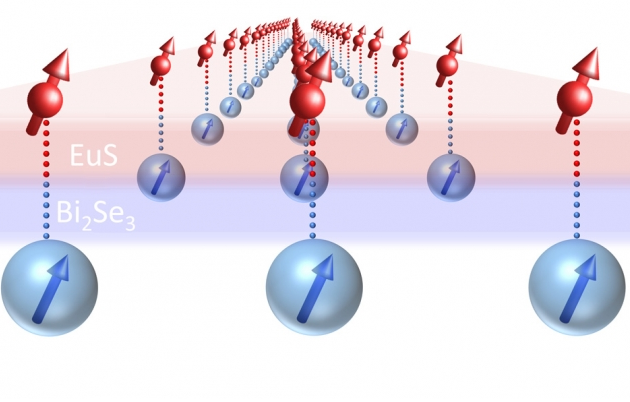An unexpected magnetic effect has taken researchers by surprise, and could open a new pathway to advanced electronic devices and even robust quantum computer architecture.
The finding is based on a family of materials known as topological insulators (TIs), which have drawn interest in recent years. The electronic properties of TIs can lead to new generations of electronic, spintronic, or quantum computing devices. Though the materials behave as ordinary insulators throughout their interiors, blocking electrons from flowing, their outermost surfaces are nearly perfect conductors, allowing electrons to move freely.

The arrows in the image above indicate the spin direction in the ferromagnetic insulator (EuS, in red), and topological insulator (Bi2Se3, in blue) at the interface between the two materials. Image source: MIT/Ferhat Katmis.
However, harnessing the materials’ promise still faces a number of obstacles, including finding a way to combine a TI with a material that has controllable magnetic properties. According to researchers at MIT, they have found a way to overcome just that.
Led by Jagadeesh Moodera of MIT’s Department of Physics along with postdoc Ferhat Katmis, the team was able to bond together several molecular layers of a topological insulator material called bismuth selenide (Bi2Se3) with an ultrathin layer of a magnetic material, europium sulfide (EuS). This resulted in a bilayer material that retains all of the exotic electronic properties of a TI, and the full magnetization capabilities of EuS.
The most surprising part about the finding was the stability of the effect. While EuS is known to retain its ability to hold a magnetic state at extremely low temperatures (17° above absolute zero), the combined material keeps those characteristics at a normal room temperature. This could make the difference for developing devices that are practical to operate, and could pave the way to new avenues of device design, as well as research into a new area of basic physical phenomena.
Originally reported in the journal, Nature , in a paper authored by Katmis, Moodera, 10 others at MIT, a multinational team from Oak Ridge, Argonne National Laboratories, and institutions in Germany, France, and India, Moodera said the magnetic effect “is an area with very little depth of research.” Getting clear, repeatable results depends on a high degree of precision in preparation of the surfaces and joining of the two materials.
According to Moodera, any contamination or imperfections can throw off the results. “What happens, happens where they meet,” he said. He noted that the careful, persistent effort of Katmis in making the materials was essential to the discovery. The finding could be a step toward new kinds of magnetic interactions at the interfaces between materials, with stability that could result in magnetic memory devices which could store information at the level of individual molecules.
“A nice thing about this is that it shows both very fundamental physics and also takes us forward to many possible applications,” Katmis said.
The team is confident that the new finding, along with other recent quantum behavior observed in TIs, can lead to many possibilities for future electronics and spintronics.
Source: MIT
Advertisement
Learn more about Electronic Products Magazine





